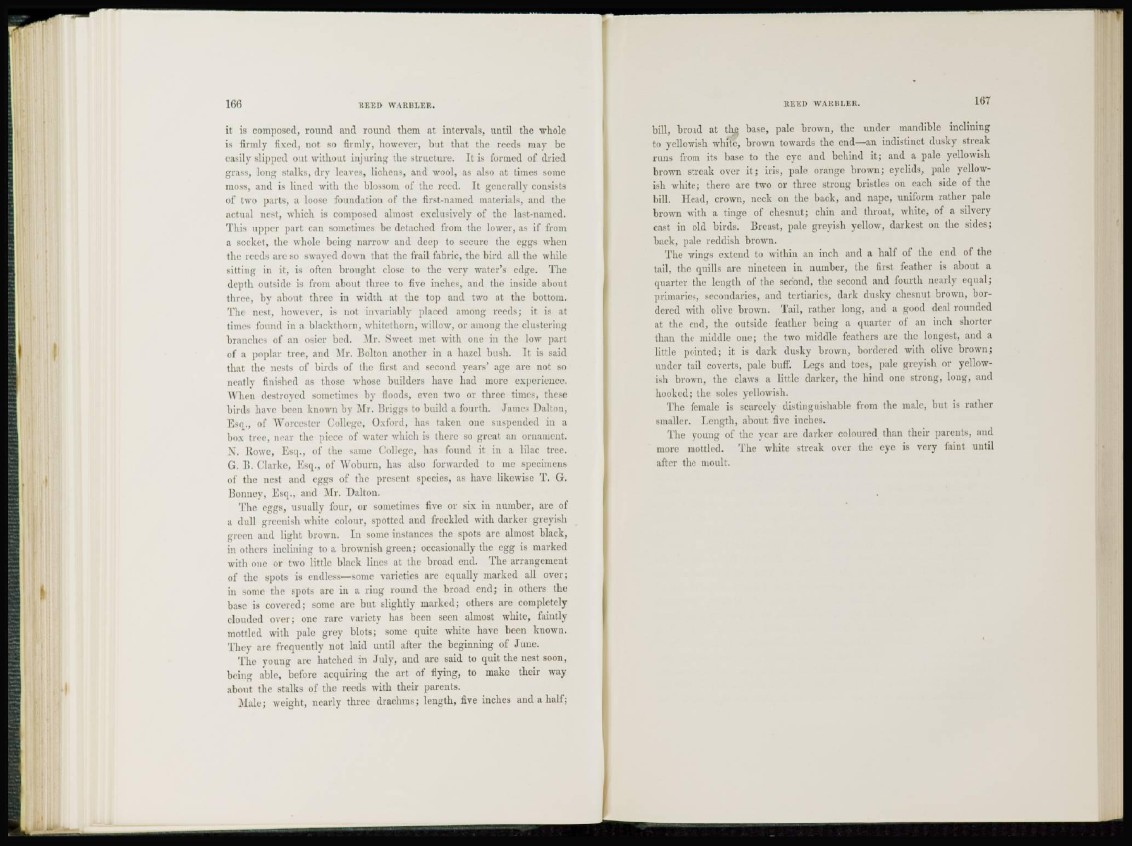
it is composed, round and round them at intervals, until the whole
is firmly fixed, not so firmly, however, but that the reeds may be
easily slipped out without injuring the structure. It is formed of dried
grass, long stalks, d r y leaves, lichens, and wool, as also at times some
moss, and is lined with the blossom of tire reed. It generally consists
ol two parts, a loose foundation of the first-named materials, and the
actual nest, which is composed almost exclusively of the last-named.
This upper part can sometimes be detached from the lower, as if from
a socket, the whole being narrow and deep to secure the eggs when
the reeds are so swayed down that the frail fabric, the bird all the while
sitting in it, is often brought (dose to the very water's edge. The
depth outside is from about three to five inches, and the inside about
three, by about three in width at the top and two at the bottom.
The nest, however, is not invariably placed among reeds; it is at
times found in a blackthorn, whitethorn, willow, or among the clustering
branches of an osier bed. Mr. Sweet met with one in the low part
of a poplar tree, and .Mr. Bolton another in a ha/el bush. It is said
that the nests of birds of the first and second years' age are not so
neatly finished as those whose builders have had more experience.
When destroyed sometimes by floods, even two or three times, these
birds have been known by Mr. Briggs to build a fourth. .Tame- Dalton,
Esq., of Worcester (lollege, Oxford. has taken 0m1 suspended in a
box tree, near the piece of water which is there so great an ornament.
X. Howe, Esq., of the same College, has found it in a lilac tree.
G. B. Clarke, Esq., of Woburn, has also forwarded to me specimens
of the nest and eggs of the present species, as have likewise T. G.
Bonney, Esq., and Mr. Dalton.
The eggs, usually four, or sometimes five or six in number, are of
a dull greenish white colour, sjiotted and freckled with darker greyish
green and light brown. In some instances the spots are almost black,
in others inclining to a brownish green; occasionally the egg is marked
with one or two little black lines at the broad end. The arrangement
of the spots is endless—some varieties are equally marked all over;
in some the spots are in a ring round the broad end; in others the
base is covered; some are but slightly marked; others are completely
clouded over; one rare variety has been seen almost white, faintly
mottled with pale grey blots; some quite white have been known.
They are frequently not laid until after the beginning of June.
The young are hatched in July, and are said to quit the nest soon,
being able, before acquiring the art of flying, to make their way
about the stalks of the reeds with their parents.
Male; weight, nearly three drachms; length, five inches and a half;
bill, broad at the, base, pale brown, the under mandible inclining
to yellowish wdiite, brown towards the end—an indistinct dusky streak
runs from its base to the eye and behind it; and a pale yellowish
brown streak over i t ; iris, pale orange brown; eyelids, pale yellowish
white; there are two or three strong bristles on each side of the
bill. Head, crown, neck on the hack, and nape, uniform rather pale
brown with a tinge of chesnut; chin and throat, wdiite, of a silvery
cast in old birds. Breast, pale greyish yellow, darkest on the sides;
back, pale reddish brown.
The wings extend to within an inch and a half of the end of the
tail, the quills are nineteen in number, the first feather is about a
quarter the length of the second, the second and fourth nearly equal;
primaries, secondaries, and tertiaries, dark dusky chesnut brown, bordered
with olive brown. Tail, rather long, and a good deal rounded
at the end, the outside feather being a quarter of an inch shorter
than the middle one; the two middle feathers arc the longest, and a
little pointed; it is dark dusky brown, bordered with olive brown;
under tad coverts, pale buff. Legs and toes, pale greyish or yellowish
brown, the claws a little darker, the hind one strong, long, and
hooked; the soles yellowish.
The female is scarcely distinguishable from the male, but is rather
smaller. Length, about five inches.
The young of the year are darker coloured than their parents, and
more mottled. The white streak over the eye is very faint until
after the moult.